 © Fifth Third Bank | All Rights Reserved Exhibit 99.1 Barclays Capital Global Financial Services Conference Kevin T. Kabat President & Chief Executive Officer September 13, 2011 Please refer to earnings release dated July 21, 2011 and 10-Q dated August 5, 2011 for further information |
 2 © Fifth Third Bank | All Rights Reserved Key themes Well-positioned for success and leadership in new banking landscape Strong levels of profitability in 2010 and throughout 2011, broad-based credit improvements, exceed fully phased-in Basel III capital standards today Completely exited all crisis-era government support programs, one of the few large banks without TLGP-guaranteed debt Continued investments in business throughout crisis to maintain and enhance revenue-generating capability while controlling expenses No significant business at Fifth Third impaired during crisis; traditional banking focus consistent with direction of financial reform |
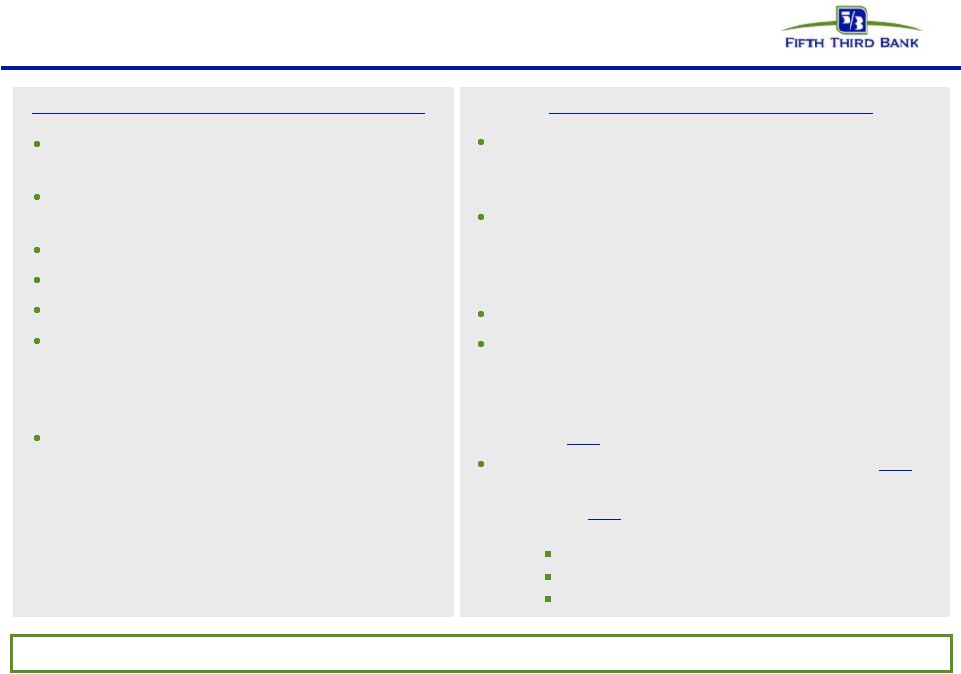 3 © Fifth Third Bank | All Rights Reserved Environment characterized by low growth expectations and low interest rates Potential lower growth and prolonged low- rate environment Lower securities reinvestment yields on portfolio cash flows Strong deposit flows Competitive dynamics Pick up in mortgage refinance activity Firms facing significant litigation related to: — Mortgage securitizations — GSE repurchases — Private label mortgage repurchases Concerns about European sovereign debt and banks / U.S. downgrade Continued strong loan production — Rates on loan originations have remained relatively stable Careful management of liability costs — Disciplined pricing on deposits — Continued evaluation of term liabilities including CDs and TruPS Stronger mortgage banking results Mortgage risks manageable — Quarterly mortgage repurchase expense ~$25mm and declining — Total mortgage securitizations outstanding $35mm and performing well (2003 HELOC) Total non-U.S. sovereign debt exposure $3mm — No peripheral* Europe sovereign debt — ~$200mm in total exposure to companies in peripheral* Europe: $30mm loans to foreign domiciled $54mm trade finance $115mm loans to US subs of above * Greece, Ireland, Italy, Portugal, Spain Fifth Third is well-positioned to deal with current environmental challenges Characteristics of current environment Fifth Third’s response / position |
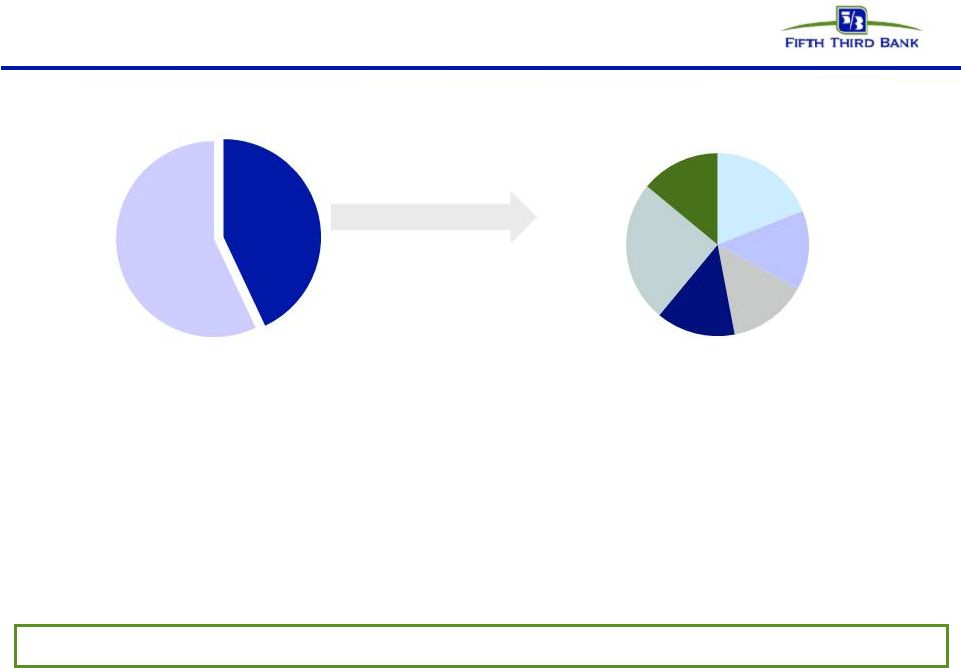 4 © Fifth Third Bank | All Rights Reserved Diverse revenue stream • — Current NII lower than normalized levels due to impact of low rate environment (e.g. low cost deposits including DDAs providing no explainable NII benefit) • Added clarity regarding effect of reform on deposit and interchange fees — Service charge impact (i.e. Reg E) already in run-rates — Initial $30 million per quarter impact of Durbin amendment expected to be mitigated over time (~1/3+ 4Q11; ~2/3 1H12; additional mitigation over time) 43% Fee income NII Fee income as % of 2Q11 revenue 2Q11 Fee income distribution Revenue results remain solid, profitability strong despite sluggish economy 57% Deposit fees Corporate banking Investment advisors Other Mortgage Card & Processing 14% 14% 14% 14% 19% 25% Business mix provides higher than average diversity among spread and fee revenues |
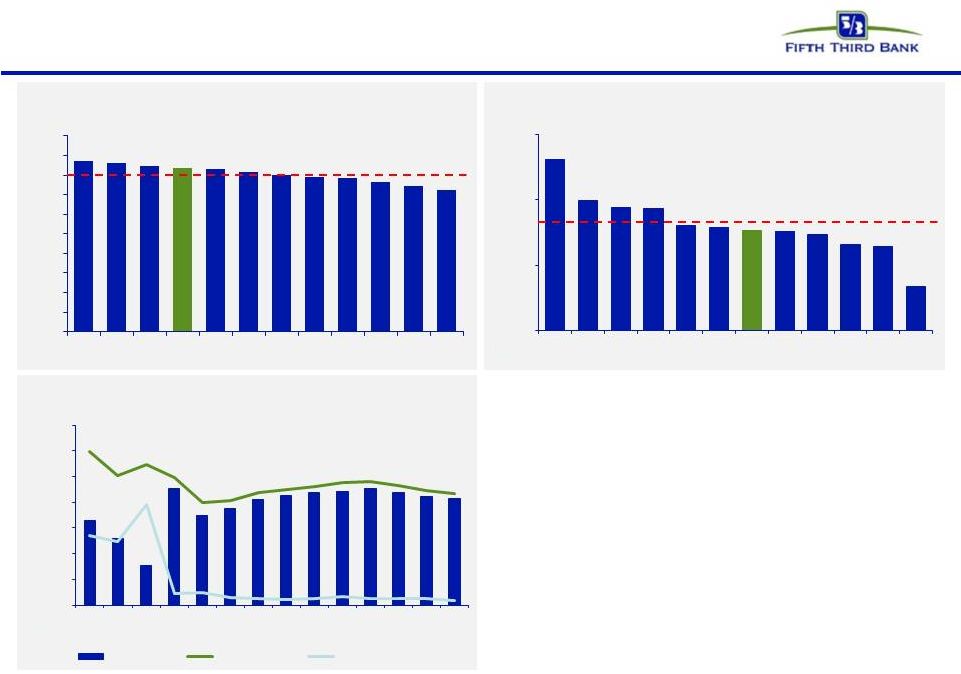 5 © Fifth Third Bank | All Rights Reserved Core funded balance sheet and pricing discipline • Strong, deposit rich core funding mix supports relatively low cost of funds – Low reliance on wholesale funding • Run-off of high cost CDs (particularly from 2H08) will benefit NII in 2H11 – $8mm benefit expected in 3Q11 with incremental $15mm in 4Q11 • Pricing discipline on commercial loans – Spreads have narrowed from post-crisis levels but remain attractive – Loan rates have stabilized the past several months SOURCE: SNL Financial and company reports. Data as of 2Q11. End of period transaction deposits defined as DDA, NOW and Savings/MMDA accounts; Cost of Funds defined as interest incurred on interest-bearing liabilities as a percentage of average noninterest-bearing deposits and interest-bearing liabilities Transaction Deposits / Total Deposits C&I Spread to 1-month LIBOR Peer average 80% Cost of Funds Peer average 0.81% 87% 86% 85% 83% 83% 82% 80% 79% 79% 77% 74% 73% 0% 10% 20% 30% 40% 50% 60% 70% 80% 90% 100% ZION MTB CMA FITB WFC STI PNC USB KEY RF BBT HBAN 1.31% 1.00% 0.94% 0.94% 0.80% 0.79% 0.76% 0.76% 0.74% 0.66% 0.64% 0.34% 0.0% 0.5% 1.0% 1.5% ZION BBT KEY USB RF STI FITB HBAN PNC MTB WFC CMA 0.0% 1.0% 2.0% 3.0% 4.0% 5.0% 6.0% 7.0% 1Q08 2Q08 3Q08 4Q08 1Q09 2Q09 3Q09 4Q09 1Q10 2Q10 3Q10 4Q10 1Q11 2Q11 C&I Yield 1 Month Libor Spread |
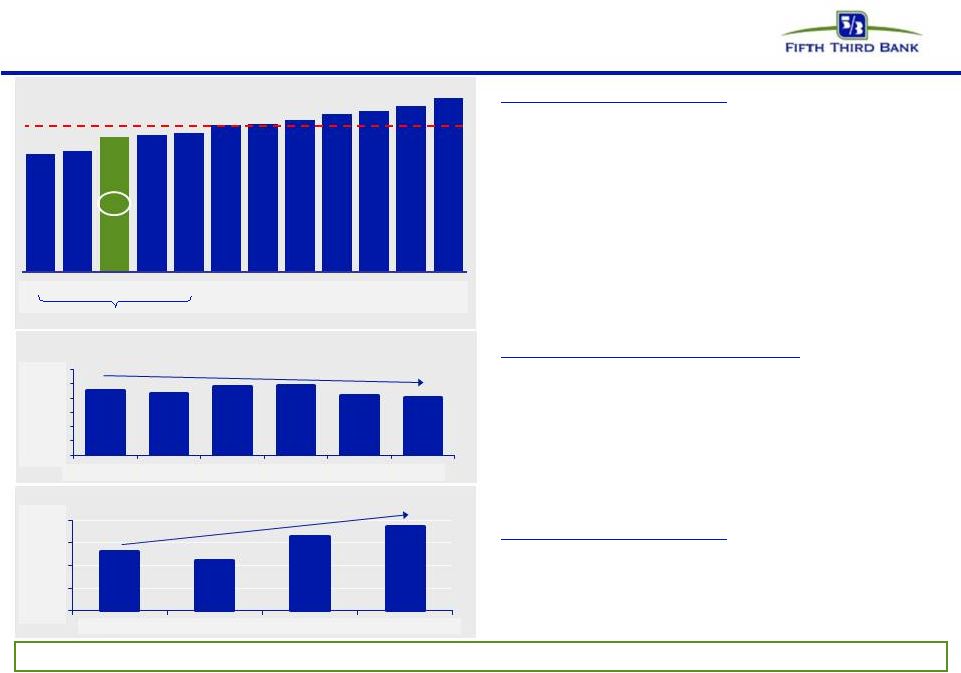 6 © Fifth Third Bank | All Rights Reserved Expense discipline Efficiency ratio* Peer average: 64% Sales / support ratio** Efficient business model: • Efficiency ratio better than most peers through weak economic environment – Reflects below-capacity balance sheet and lower revenue than we expect and can support longer term – Current impact of credit costs on revenue and expenses Disciplined expense management • Expenses being managed carefully in response to revenue environment – Down 6% versus early 2010 – Continuous process of expense evaluation at Fifth Third Investment for the future: • Sales to support ratio has increased through careful management of back office and front office staff Managing expenses for current revenue environment and long-term franchise value Noninterest expense trend ($mm) (6%) Significant purchase accounting benefit (ex-FITB) * Source: Company reports. Data as of 2Q11. Efficiency ratio calculated as reported noninterest expense / (net interest income (fully taxable equivalent)+ noninterest income) ** Sales / support ratio calculated as Sales Headcount (full-time equivalent) / Support Headcount (full-time equivalent) 52% 53% 59% 60% 61% 64% 65% 66% 69% 70% 72% 76% USB MTB FITB PNC WFC BBT HBAN KEY CMA STI RF ZION $956 $935 $979 $987 $918 $901 $500 $700 $900 $1,100 1Q10 2Q10 3Q10 4Q10 1Q11 2Q11 100% 110% 120% 130% 140% 4Q08 4Q09 4Q10 2Q11 $1,000 $800 $600 |
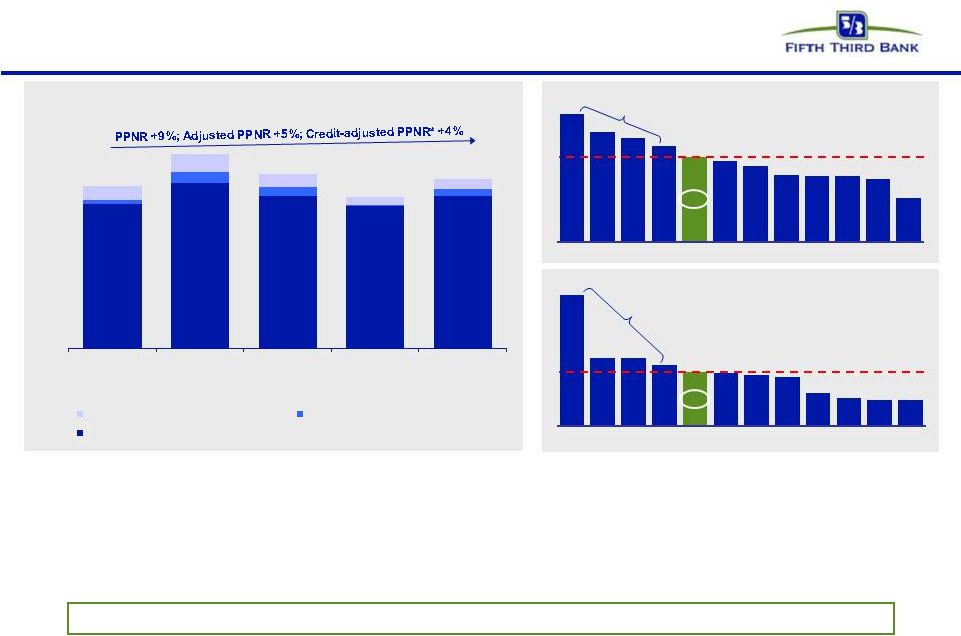 7 © Fifth Third Bank | All Rights Reserved Strong pre-provision net revenue PPNR trend Pre-provision net revenue (PPNR): net interest income plus noninterest income minus noninterest expense. Adjusted PPNR excludes securities gains / losses, other than temporary impairment gains / losses, and other related one-time items. Refer to appendix for reconciliation and detailed breakout of credit-related adjustments. Source: SNL Financial and company reports. Data as of 2Q11. * There are limitations on the usefulness of credit-adjusted PPNR, including the significant degree to which changes in credit and fair value are integral, recurring components of the Bancorp’s core operations as a financial institution. This measure has been included herein to facilitate a greater understanding of the Bancorp’s financial condition. ** NPAs exclude covered assets for BBT, USB, ZION • 2Q11 PPNR of $619mm up 14% from 1Q11 levels, and up 9% over prior year – Reflects improved noninterest income and noninterest expense, partially offset by a decrease in net interest income • Adjusted PPNR of $582mm up 7% sequentially and 5% year-over-year – Includes negative adjustments totaling $37mm – Results also included $64mm in credit related costs Adjusted PPNR / Risk-weighted assets Adjusted PPNR / Nonperforming assets (HFI) ** Robust pre-provision profitability = capacity to absorb losses and strong bottom line Significant purchase accounting benefit Peer avg.: 2.3% Peer avg.: 111% Significant purchase accounting benefit PPNR $567 $760 $583 $545 $619 552 634 581 545 582 15 42 34 3 28 55 67 53 32 36 2Q10 3Q10 4Q10 1Q11 2Q11 Fee Income Credit Items Adjusted PPNR 3.5% 3.0% 2.9% 2.6% 2.3% 2.2% 2.1% 1.8% 1.8% 1.8% 1.7% 1.2% USB WFC BBT PNC FITB MTB HBAN STI ZION RF KEY CMA 270% 139% 139% 126% 111% 109% 104% 102% 67% 58% 53% 52% USB KEY HBAN PNC FITB MTB WFC BBT CMA STI ZION RF Noninterest Expense Credit Items |
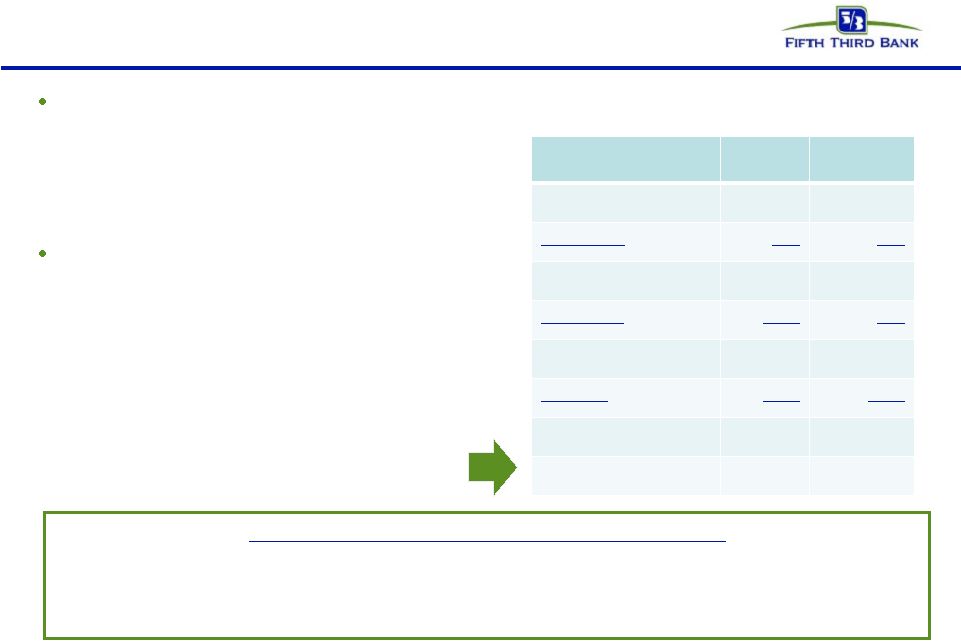 8 © Fifth Third Bank | All Rights Reserved Expect ROAA upside longer-term Second quarter ROA of 1.22% included — Provision expense / average loans of 58 bps — $64mm of credit-related costs in revenue and expense Elevated credit costs should decline as conditions normalize — Credit-related costs historically of ~$25mm (pre-credit crisis) — 1997-2006 Average Provision / Loans of ~50 bps (45 bps average net charge-off ratio) — 2Q11 results and historical average credit results would produce an ROAA of approximately 1.4% Long-term target of 1.3 – 1.5% return on assets Earning asset growth Mid-50% efficiency ratio long-term NIM of 3.5-4.0% Provision of 40-60 bps Fees / Revenue ~40% Mitigation of financial reform 2Q11 Actual 2Q11 Illustrative PPNR ex-credit costs** $683 $683 Credit costs (64) (25) PPNR 619 658 Provision*** (113) (97) Pre-tax income 506 561 Taxes**** (169) (168) Net Income 337 393 ROAA 1.22% 1.42% Illustrative ROA calculation using historical NCO and credit-related costs* * Not a projection ** PPNR before inclusion of credit costs *** Illustrative provision calculated using 50 bps historical average provision / loan ratio **** Illustrative taxes assumed effective tax rate of ~30% Upper end of ROA target range assumes balance sheet growth and normalized rate environment |
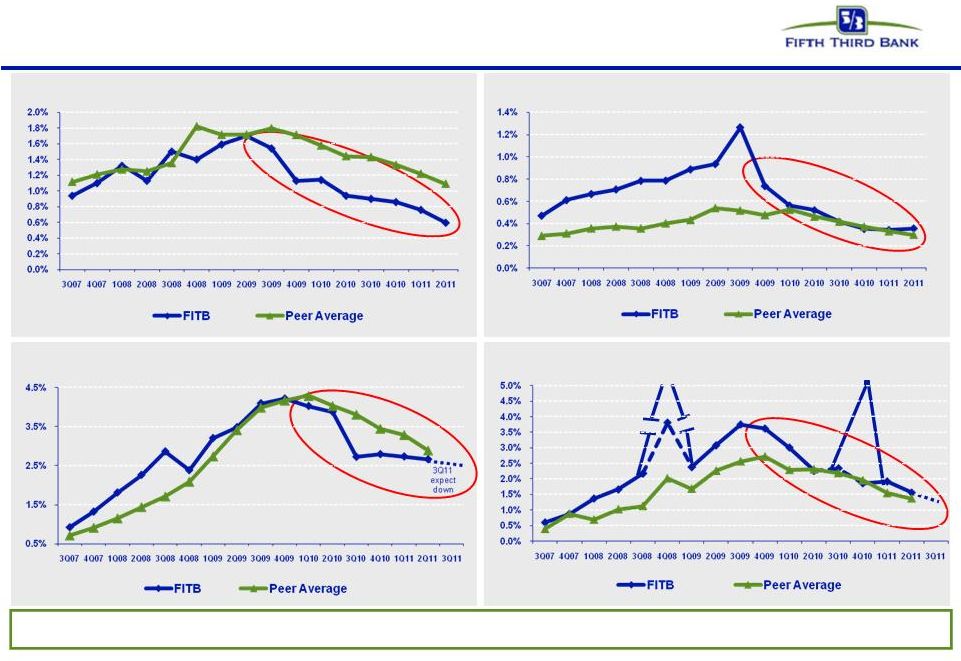 9 © Fifth Third Bank | All Rights Reserved Strong relative credit trends NPA ratio vs. peers Net charge-off ratio vs. peers Loans 90+ days delinquent % vs. peers Loans 30-89 days delinquent % vs. peers (7.5%)* (HFS transfer) 3.8% Before credit actions 5.0%* 3Q11 expect down 2.3% Before credit actions FITB credit metrics are in line with or better than peers Peer average includes: BBT, CMA, HBAN, KEY, MTB, PNC, RF, STI, USB, WFC, and ZION Source: SNL Financial and company filings. All ratios exclude loans held-for-sale and covered assets for peers where appropriate. * 4Q08 NCOs included $800mm in NCOs related to commercial loans moved to held-for-sale; 3Q10 NCOs included $510mm in NCOs related to loans sold or moved to held-for-sale |
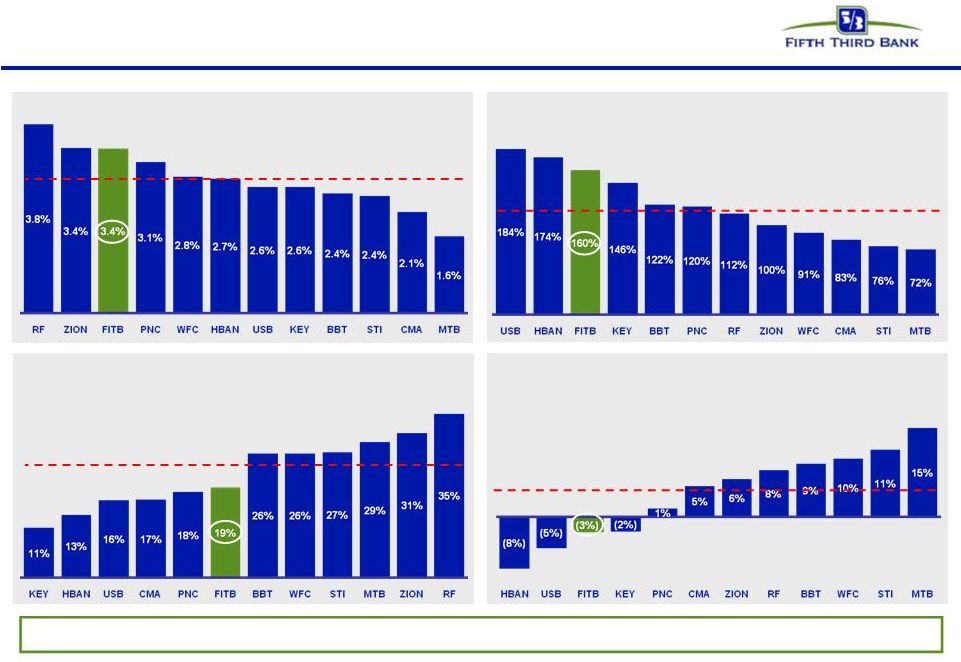 10 © Fifth Third Bank | All Rights Reserved Strong credit coverage levels Source: SNL Financial and company reports. Data as of 2Q11. HFI NPAs and NPLs exclude loans held-for-sale and also exclude covered assets for BBT, USB, and ZION “Texas Ratio” (HFI NPAs + Over 90s) / (Reserves + TCE) Peer average: 23% Reserves / NPLs Peer average: 116% (HFI NPAs + Over 90s – Reserves) / TCE Peer average: 4% Reserves / Loans Peer average: 2.7% Reserves and capital levels significant in relation to problem assets |
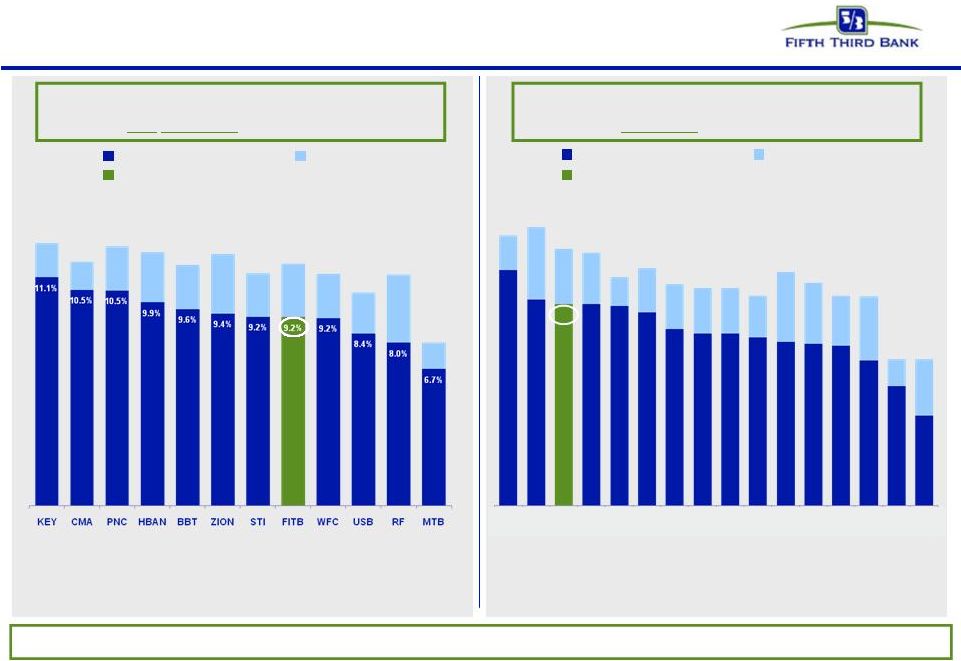 11 © Fifth Third Bank | All Rights Reserved Strong capital position, Basel I and Basel III Tier 1 common (peers) Tier 1 common (FITB) Reserves 12.8% 11.9% 12.6% 11.7% 12.3% 12.3% 11.8% 11.3% 10.4% 11.3% 7.9% 11.3% Peers* not in order of graph at left; estimated Reserves Tier 1 common (peers) Tier 1 common (FITB) 12.2% Bank Bank FITB Bank Bank Bank Bank Bank Bank Bank Bank Bank Bank Bank Bank Bank 1 2 3 4 5 6 7 8 9 10 11 12 13 14 15 9.6% (Tier 1 common + reserves) / RWA (not adjusted for Basel III) (Tier 1 common + reserves) / RWA (adjusted for Basel III) Fifth Third’s capital position already well in excess of established standards, likely standards, and most peers Source: SNL Financial, company filings, and third-party estimates. Regulatory financial data as of 2Q11. * Peers include BAC, BBT, C, CMA, COF, HBAN, JPM, KEY, MTB, PNC, RF, STI, USB, WFC, ZION Note: Estimates based on current Basel III rules released by the Basel Committee; actual rules subject to U.S. banking regulation. Assumes unrealized securities gains included in Tier 1 common. Not adjusted for potential mitigation efforts. Four large peers include estimated Basel III RWA impact based on BIS proposals. |
 12 © Fifth Third Bank | All Rights Reserved Capital management philosophy * Subject to Board of Directors and regulatory approval ** Comprehensive Capital Adequacy Review by Federal Reserve; proposed future capital actions confidentially submitted Organic growth opportunities • Support growth of core banking franchise • Continued loan growth despite sluggish economy Return to more normal dividend policy * • Strong levels of profitability would support significantly higher dividend than current level • Incorporated higher dividends in 1Q11 CCAR ** submission Strategic opportunities * • Prudently expand franchise or increase density in core markets via disciplined acquisitions or de novos • Attain top 3 market position in 65% of markets or more longer term • Expect future acquisition activity although less likely in near-term Repurchases / Redemptions * • Common shares: — Manage excess capital in light of regulatory environment, other deployment alternatives, maintenance of buffers over targeted / required capital levels, and stock price — Not included in 1Q11 CCAR** submission • Trust preferred shares (TruPS): — Potential redemption of certain TruPS included in 1Q11 CCAR ** submission — Have called $517mm due to regulatory capital treatment event or on normal call dates — Will evaluate remaining TruPS in context of regulatory developments and desired capital structure given continued changes in regulations Strong internal capital generation; current long-term Tier 1 common equity target of ~8% |
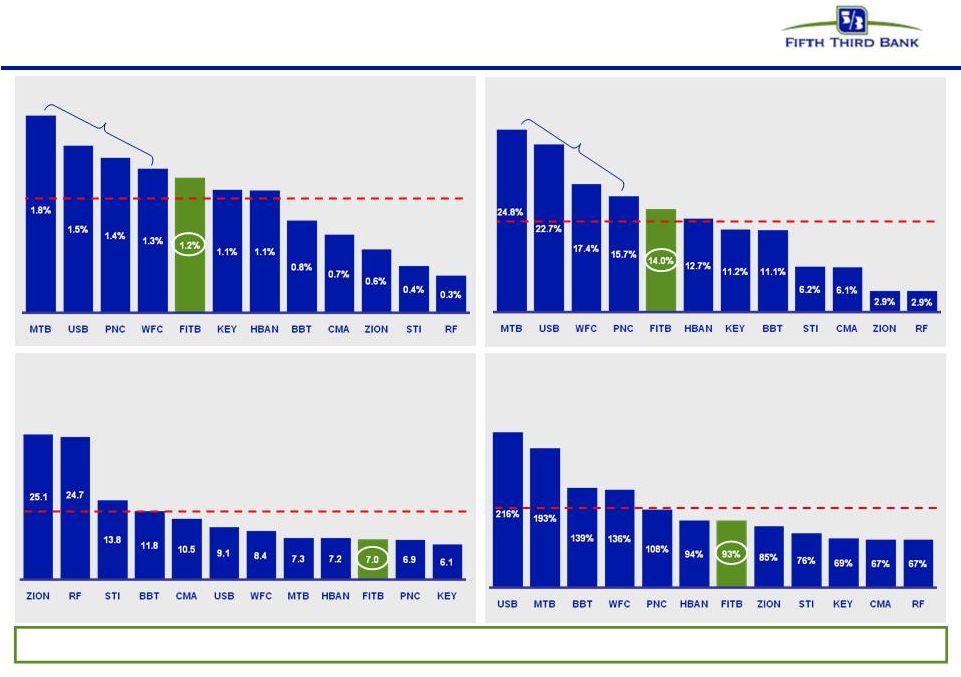 13 © Fifth Third Bank | All Rights Reserved Strong returns drive capital generation * 2Q11 annualized Price as of 9/9/11 Price / Tangible Book Value Peer average: 113% Return on Average Tangible Common Equity* Peer average: 12.2% Significant purchase accounting benefit Return on Average Assets* Peer average: 1.0% Price / Earnings* Peer average: 11.9 Significant purchase accounting benefit Well above average profitability and capital generation, well below average valuation |
 14 © Fifth Third Bank | All Rights Reserved Customer-centric traditional banking model: well-positioned for changed financial landscape Fifth Third’s business model is driven by traditional banking activities, consistent with direction of financial reform — Dodd-Frank / Basel III do not require substantial changes to Fifth Third’s business model or asset mix with attendant execution risk — Low level of financial system “interconnectedness” – International activity primarily related to trade finance and lending to U.S. subsidiaries of foreign companies – (e.g.) Fifth Third loss in Lehman bankruptcy expected to be less than $2mm — Little to no impact from Volcker rule (de minimis market maker in derivatives, proprietary trading) – Daily VaR ~$1mm or less – Small private equity portfolio ~$100mm — No originations of CDOs, securitizations on behalf of others — Didn’t originate or sell subprime mortgages or Option ARMs — No mortgage securitizations outstanding (except ~$35mm HELOC from 2003) Business profile positions Fifth Third well – today and in the future No significant business at Fifth Third impaired during crisis |
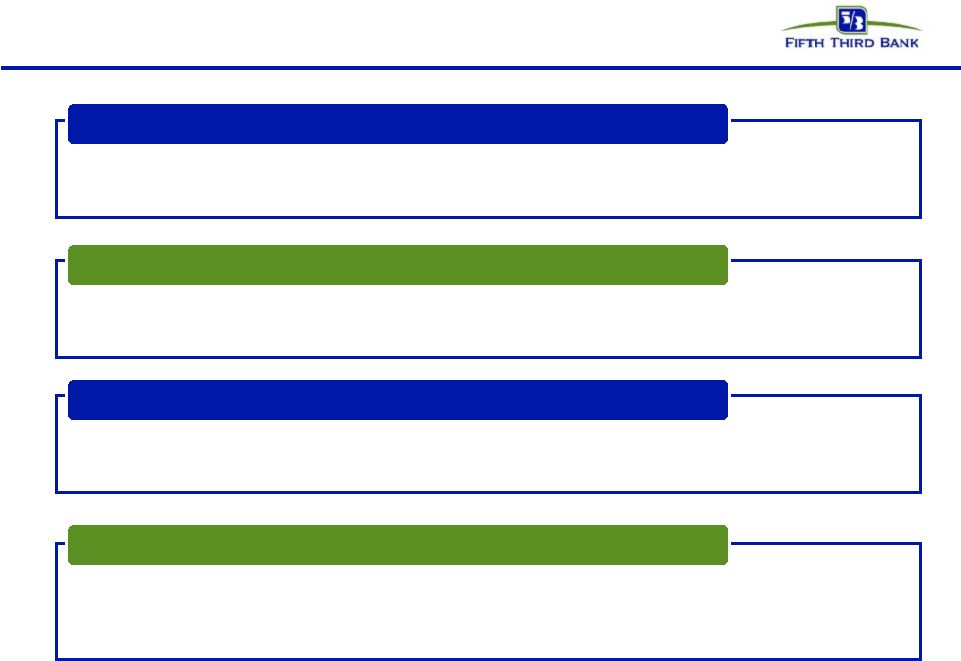 15 © Fifth Third Bank | All Rights Reserved Well-positioned for the future • Holding company cash currently sufficient for nearly 2 years of obligations; no holding company or Bank debt maturities until 2013 • Fifth Third has completely exited all crisis-era government support programs – Fifth Third is one of the few large banks that have no TLGP-guaranteed debt to refinance in 2012 Superior capital and liquidity position • NCOs below 1.6%; 2.1x reserves / annualized NCOs • $1.2B problem assets addressed through loan sales and transfer to HFS in 3Q10 • Substantial reduction in exposure to CRE since 1Q09; relatively low CRE exposure versus peers Proactive approach to risk management • Traditional commercial banking franchise built on customer-oriented localized operating model • Strong market share in key markets with focus on further improving density • Fee income ~40% of total revenues Diversified traditional banking platform • PPNR has remained strong throughout the credit cycle • PPNR substantially exceeds annual net charge-offs (204% PPNR / NCOs in 2Q11) • 1.2% ROAA; 14% return on average tangible common equity Industry leader in earnings power |
 16 © Fifth Third Bank | All Rights Reserved Cautionary statement This report contains statements that we believe are “forward-looking statements” within the meaning of Section 27A of the Securities Act of 1933, as amended, and Rule 175 promulgated thereunder, and Section 21E of the Securities Exchange Act of 1934, as amended, and Rule 3b-6 promulgated thereunder. These statements relate to our financial condition, results of operations, plans, objectives, future performance or business. They usually can be identified by the use of forward-looking language such as “will likely result,” “may,” “are expected to,” “is anticipated,” “estimate,” “forecast,” “projected,” “intends to,” or may include other similar words or phrases such as “believes,” “plans,” “trend,” “objective,” “continue,” “remain,” or similar expressions, or future or conditional verbs such as “will,” “would,” “should,” “could,” “might,” “can,” or similar verbs. You should not place undue reliance on these statements, as they are subject to risks and uncertainties, including but not limited to the risk factors set forth in our most recent Annual Report on Form 10-K. When considering these forward-looking statements, you should keep in mind these risks and uncertainties, as well as any cautionary statements we may make. Moreover, you should treat these statements as speaking only as of the date they are made and based only on information then actually known to us. There are a number of important factors that could cause future results to differ materially from historical performance and these forward- looking statements. Factors that might cause such a difference include, but are not limited to: (1) general economic conditions and weakening in the economy, specifically the real estate market, either nationally or in the states in which Fifth Third, one or more acquired entities and/or the combined company do business, are less favorable than expected; (2) deteriorating credit quality; (3) political developments, wars or other hostilities may disrupt or increase volatility in securities markets or other economic conditions; (4) changes in the interest rate environment reduce interest margins; (5) prepayment speeds, loan origination and sale volumes, charge-offs and loan loss provisions; (6) Fifth Third’s ability to maintain required capital levels and adequate sources of funding and liquidity; (7) maintaining capital requirements may limit Fifth Third’s operations and potential growth; (8) changes and trends in capital markets; (9) problems encountered by larger or similar financial institutions may adversely affect the banking industry and/or Fifth Third; (10) competitive pressures among depository institutions increase significantly; (11) effects of critical accounting policies and judgments; (12) changes in accounting policies or procedures as may be required by the Financial Accounting Standards Board (FASB) or other regulatory agencies; (13) legislative or regulatory changes or actions, or significant litigation, adversely affect Fifth Third, one or more acquired entities and/or the combined company or the businesses in which Fifth Third, one or more acquired entities and/or the combined company are engaged, including the recently enacted Dodd-Frank Wall Street Reform and Consumer Protection Act; (14) ability to maintain favorable ratings fro rating agencies; (15) fluctuation of Fifth Third’s stock price; (16) ability to attract and retain key personnel; (17) ability to receive dividends from its subsidiaries; (18) potentially dilutive effect of future acquisitions on current shareholders’ ownership of Fifth Third; (19) effects of accounting or financial results of one or more acquired entities; (20) difficulties in separating Vantiv, LLC, formerly Fifth Third Processing Solutions from Fifth Third; (21) loss of income from any sale or potential sale of businesses that could have an adverse effect on Fifth Third’s earnings and future growth; (22) ability to secure confidential information through the use of computer systems and telecommunications networks; and (23) the impact of reputational risk created by these developments on such matters as business generation and retention, funding and liquidity. You should refer to our periodic and current reports filed with the Securities and Exchange Commission, or “SEC,” for further information on other factors, which could cause actual results to be significantly different from those expressed or implied by these forward-looking statements. |
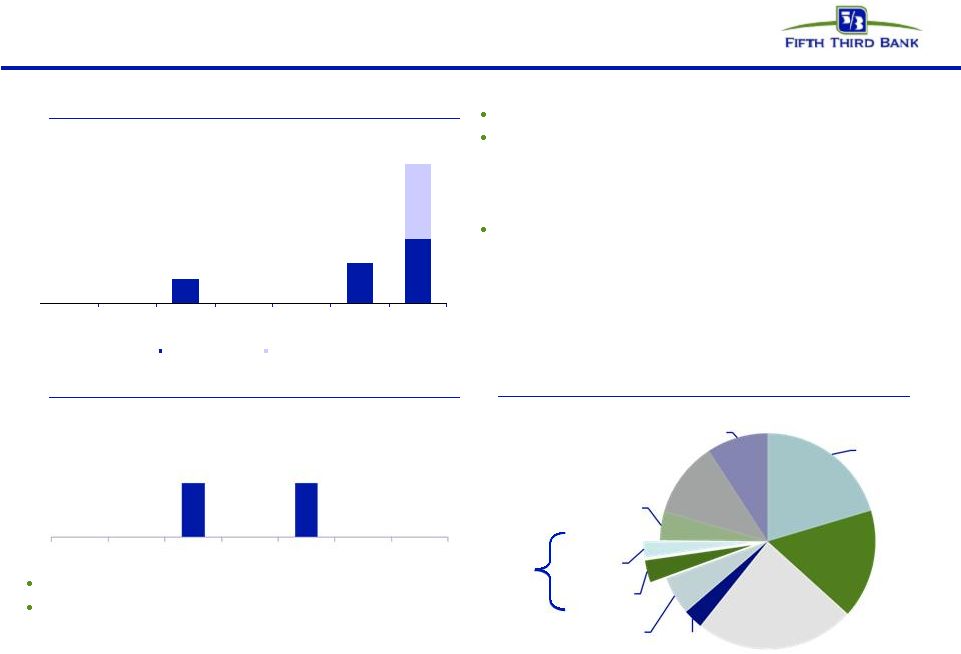 17 © Fifth Third Bank | All Rights Reserved 2011 2012 2013 2014 2015 2016 2017 on Fifth Third Bancorp Fifth Third Capital Trust $4,313 $750 Liquidity levels elevated in 3Q11 As of 2Q11, readily available borrowing capacity at FHLB: $6.1B; contingent borrowing capacity at the Fed: $20.8B — Executed $2.5B in three-month FHLB borrowings in July as a precaution to supplement liquidity through the discussion and resolution of the U.S. debt ceiling limit Holding Company cash at 6/30/11: $1.3B Cash currently sufficient to satisfy all fixed obligations for nearly 2 years (debt maturities, common and preferred dividends, interest and other expenses) without accessing capital markets; relying on dividends from subsidiaries; proceeds from asset sales Expected cash obligations over the next 12 months — $0 debt maturities — ~$221mm common dividends (at $0.06 dividend) — ~$35mm Series G preferred dividends — ~$450mm interest and other expenses Holding company unsecured debt maturities ($mm) Heavily core funded $1,250 Strong liquidity profile S-T wholesale 6% $2 $500 $500 2011 2012 2013 2014 2015 2016 2017 on Demand 21% Interest checking 16% Savings/ MMDA Foreign office 3% Consumer time 6% Non-core deposits 3% S-T borrowings 3% Other liabilities 4% Equity 11% L-T debt 9% Bank unsecured debt maturities ($mm – excl. Brokered CDs) 24% |
 18 © Fifth Third Bank | All Rights Reserved Mortgage repurchase overview Demand requests and repurchase losses remain volatile; near-term repurchase losses are expected to remain somewhat elevated Virtually all sold loans and new claims relate to agencies — 98% of outstanding balance of loans sold — 87% of currently outstanding claims Majority of outstanding balances of the serviced for others portfolio relates to origination activity in 2009 and later Private claims and exposure relate to whole loan sales (no outstanding first mortgage securitizations) — Preponderance of private sales prior to 2006 Repurchase Reserves* ($ in millions) 2Q10 3Q10 4Q10 1Q11 2Q11 Beginning balance $84 $85 $103 $101 $87 Net reserve additions 19 47 21 10 15 Repurchase losses (18) (29) (23) (23) (22) Ending balance $85 $103 $101 $87 $80 Outstanding Counterparty Claims ($ in millions) Outstanding Balance of Sold Loans ($ in millions) 2005 and prior GSE GNMA Private Total $8,388 $318 $613 $9,319 2006 1,915 67 289 2,271 2007 3,119 99 252 3,470 2008 3,248 774 3 4,024 2009 and later 28,677 8,264 1 36,942 Total $45,348 $9,522 $1,155 $56,025 * Includes reps and warranty reserve ($60mm) and reserve for loans sold with recourse ($20mm) |
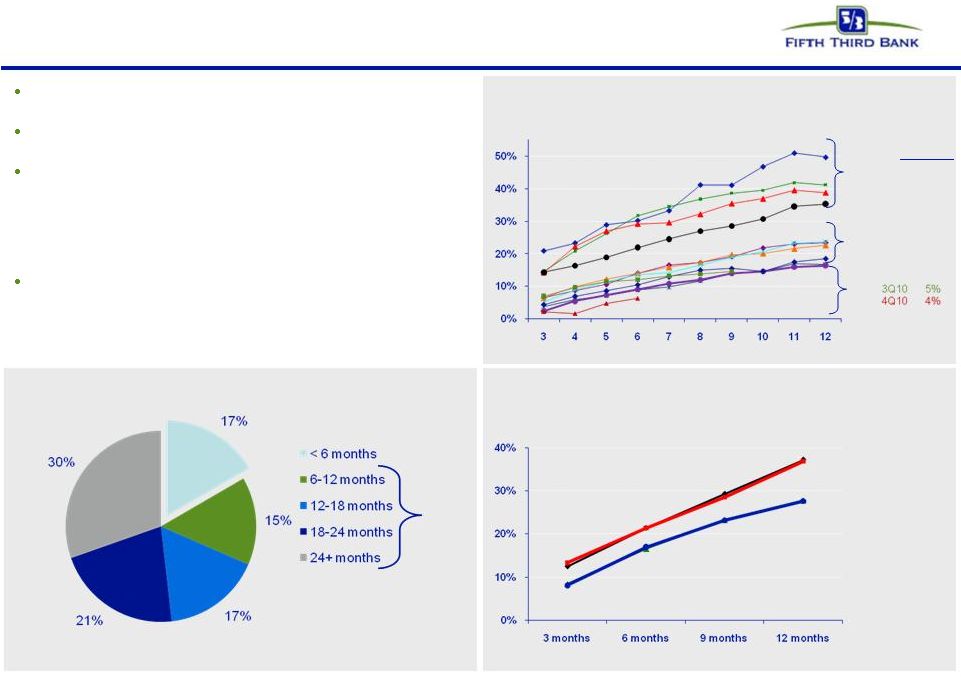 19 © Fifth Third Bank | All Rights Reserved Troubled debt restructurings overview Successive improvement in vintage performance during 2008 and 2009 as volume of modification increased Fifth Third’s mortgage portfolio TDRs have redefaulted at a lower rate than GSE composites Of $1.8B in consumer TDRs, $1.6B were on accrual status and $211mm were nonaccruals — $1.1B of TDRs are current and have been on the books 6 or more months; within that, nearly $920mm of TDRs are current and have been on the books for more than a year As current TDRs season, their default propensity declines significantly — We see much lower defaults on current loans after a vintage approaches 12 months since modification TDR performance has improved in newer vintages Outperforming redefault benchmarks Source: Fifth Third and OCC/OTS data through 4Q10 Mortgage TDR 60+ redefault trend by vintage* 1Q08 4% 2Q08 7% 3Q08 8% 4Q08 9% 1Q09 12% 2Q09 13% Months since modification Mortgage TDR 60+ redefault rate: Fifth Third comparison (January 1, 2008 through March 2011)* Fannie Mae Industry portfolio loans Fifth Third Volume by vintage Freddie Mac 3Q09 13% $1.3B current consumer TDRs (%) 4Q09 8% $1.1 billion 2008 2009 1Q10 7% 2Q10 5% * Fifth Third data includes changes made to align with OCC/OTS methodology (i.e. excludes government loans, closed loans and OREO from calculations) 2010 |
 20 © Fifth Third Bank | All Rights Reserved NPL rollforward Significant improvement in NPL inflows over past two years Consumer NPL inflows restated to conform with call report guidelines NPL HFI Rollforward Commercial 2Q09 3Q09 4Q09 1Q10 2Q10 3Q10 4Q10 1Q11 2Q11 Beginning NPL Amount 1,937 2,110 2,430 2,392 2,172 1,980 1,261 1,214 1,211 New nonaccrual loans 544 832 602 405 310 290 224 299 309 Paydowns, payoffs, sales and net other activity (190) (246) (332) (425) (402) (630) (168) (199) (177) Charge-offs (181) (266) (308) (200) (100) (379) (103) (103) (90) Ending Commercial NPL 2,110 2,430 2,392 2,172 1,980 1,261 1,214 1,211 1,253 Consumer 2Q09 3Q09 4Q09 1Q10 2Q10 3Q10 4Q10 1Q11 2Q11 Beginning NPL Amount 459 477 517 555 561 550 323 466 434 New nonaccrual loans 157 166 193 170 238 182 283 153 140 Net other activity (139) (126) (155) (164) (249) (409) (140) (185) (188) Ending Consumer NPL 477 517 555 561 550 323 466 434 386 Total NPL 2,587 2,947 2,947 2,733 2,530 1,584 1,680 1,645 1,639 Total new nonaccrual loans - HFI 701 998 795 575 548 472 507 452 449 |
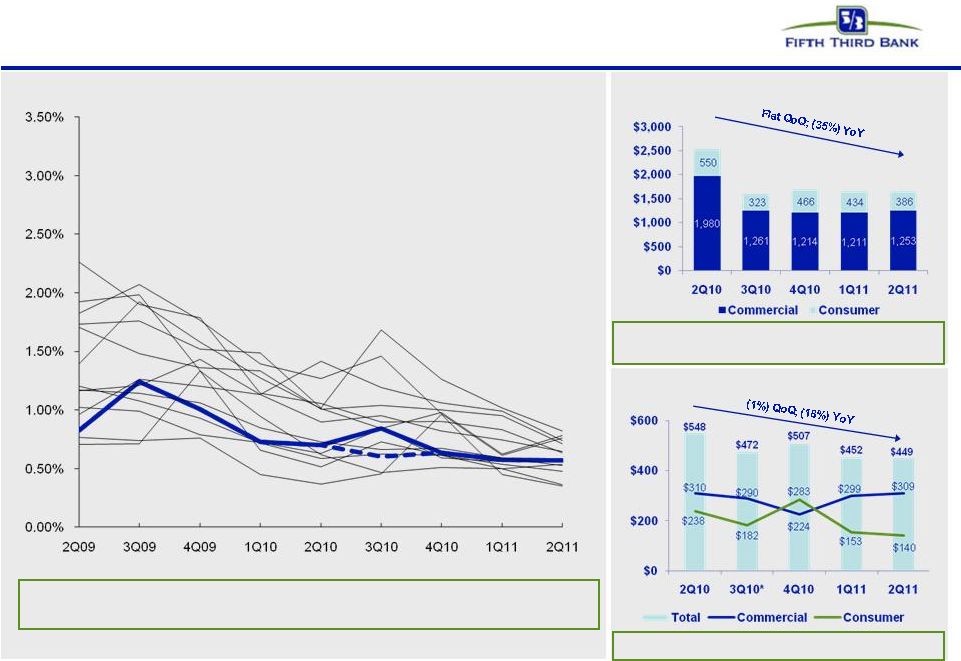 21 © Fifth Third Bank | All Rights Reserved Non-performing loans Non-performing loans ($mm) $2.5B $1.6B Non-performing loans improving with lower severity mix; benefit of sales/transfers $1.6B Fifth Third’s non-performing loan inflows (relative to loans) have been proportionally lower than peers FITB NPL inflows (relative to loans) vs. peers FITB Source: SNL Financial and company filings. Peers include: BAC, BBT, C, CMA, HBAN, JPM, KEY, MTB, PNC, RF, STI, USB, and WFC New HFI non-performing loan flows ($mm) NPL inflows down significantly $1.7B * 3Q10 inflows into NPLs HFS were $217mm, reflecting performing loans moved to held-for-sale in 3Q10 that were deemed impaired as a result of the decision to sell these loans See slide 20 for more information Consumer NPL inflows restated to conform with call report guidelines $1.6B FITB ex-HFS |
  22 © Fifth Third Bank | All Rights Reserved Regulation G Non-GAAP reconciliation $ in millions (unaudited) June March December September June 2011 2011 2010 2010 2010 Pre-tax Pre-provision Net Revenue: Income before income taxes (a) 506 $ 377 $ 417 $ 303 $ 242 $ Provision expense (b) 113 168 166 457 325 Pre-tax, pre-provision net revenue (PPNR) (a) + (b) 619 545 583 760 567 Annualized PPNR (c) 2,483 2,210 2,313 3,015 2,274 Adjustments remove (benefit) / detriment Securities (gains) / losses (6) (8) (21) (4) (8) Gain on BOLI settlement - - - (127) - Valuation of 2009 Visa total return swap 4 9 5 - - Vantiv, LLC warrants & puts (29) 2 (3) 5 (10) Other litigation reserve expense - - - - 3 Extinguishment (gains) / losses (6) (3) 17 - - Adjusted PPNR 582 545 581 634 552 Annualized Adjusted PPNR (d) 2,328 2,180 2,324 2,536 2,208 Credit-related items in noninterest income Gain / (loss) on sale of loans 8 17 21 (1) 6 Commercial loans HFS FV adjustment (9) (16) (35) (9) (7) Gain / (loss) on sale of OREO properties (26) (2) (19) (29) (13) Mortgage repurchase costs (0) (2) (1) (2) (1) Total credit-related revenue impact 28 3 34 42 15 Credit-related items in noninterest expense Mortgage repurchase expense 14 8 20 45 18 Provision for unfunded commitments (14) (16) (4) (23) (6) Derivative valuation adjustments 1 (0) (1) 8 9 OREO expense 6 13 11 9 7 Other problem asset related expenses 30 28 27 28 26 Total credit-related operating expenses 36 32 53 67 55 Credit-adjusted PPNR 646 580 668 743 622 Financial & Asset Quality Metrics: Risk-weighted assets (e) 100,319 $ 99,392 $ 100,561 $ 98,904 $ 98,604 $ Net charge-offs 304 367 356 956 434 Annualized net charge-offs (f) 1,219 1,488 1,412 3,793 1,741 HFI Nonperforming assets (g) 2,088 2,126 2,174 2,082 2,969 Ratios: PPNR / RWA (c) / (e) 2.5% 2.2% 2.3% 3.0% 2.3% PPNR / NCO (c) / (f) 204% 149% 164% 79% 131% PPNR / HFI NPA (c) / (g) 119% 104% 106% 145% 77% Adjusted PPNR / RWA (d) / (e) 2.3% 2.2% 2.3% 2.6% 2.2% Adjusted PPNR / NCO (d) / (f) 191% 146% 165% 67% 127% Adjusted PPNR / HFI NPA (d) / (g) 111% 103% 107% 122% 74% For the Three Months Ended |